Here’s the third episode as promised. The class marks out and cuts out the moulds, knees and transoms to build two small clinker dinghies.

Here’s the third episode as promised. The class marks out and cuts out the moulds, knees and transoms to build two small clinker dinghies.
We filmed a Summer School class in 2000, and it’s taken me until now to edit it. It’s the first in a series which will eventually be accompanied by a thorough book on Traditional Clinker Construction. The first two episodes are here, the following episodes will appear….well, episodically, probably a few months apart. I’ve explained some complicated processes as best I
can, but you’ll still need a textbook. If you want to start your project before the series finishes and the book comes out, you can get a fair bit on lofting from both THE OPEN BOAT and WOODEN BOATBUILDING- THE SYDNEY WOODEN BOAT SCHOOL MANUALS, and the latter also includes the original manual on Building a Traditional Clinker Dinghy.
Splining cracks in clinker planks.
BRITANNIA gets a new ringtail spar by the traditional method.
After 16 hard seasons of racing a few planks on the batten-seam carvel hull needed repairs.
Fitting structural floor timbers to my carvel-planked Ranger class gaff sloop.
How I drilled for the shaft tube on my 24′ traditional gaff sloop.
Stealer planks are let into a host plank where the host plank can’t be wide enough to cover the area it needs to.
Stopwaters prevent water migrating along joints in the backbone timbers in carvel-planked construction.
A severe bend and twist means that I have to steam the Huon Pine planks in my carvel-planked 24′ new build.
Bending the ribs into my 24′ Ranger class gaff sloop. Some are a single piece of timber, some are two laminations, some are of three laminations.

This A3 poster of images from The Open Boat book is printed on fine paper suitable for framing. The images are of the sails set by 18-Footers in the first half of the 20th Century. The upper images are of the upwind and downwind rigs carried by Britannia (1919),and the lower images are of the upwind and downwind rigs carried by Top Weight (1947). Posted in a tube for $10 within Australia, $13 to New Zealand, $17 to USA and Canada, $23 to UK and Ireland, $24 to France, Spain, Germany and rest of EU, and $28 to the rest of the world. A3, 42 x 29.7cm (16.535″ x 11.693″).
How to make a half-hull model. The example in this video is an Aussie 10-footer from 1906, and was made as a trophy for the historical 10-footer fleet.
Building the 18 footer Britannia, a replica of an iconic Sydney 18-footer of 1919, in the early 2000’s. Don’t know of any other videos that show batten-seam carvel construction.
We have gathered together a small group of wooden boat plans from several different designers, including dinghies, sailing vessels and power boats. All have been built through the School, some of them multiple times. Many of them can be built with a choice of methods, from fully traditional to modern laminated methods. Some appear below, and we will continuously add to the list. How to build them was written up in the Sydney Wooden Boat School Manuals which evolved from the classes at the School in the 1990’s, and they have been updated and combined into a single book which comprises the original manuals “Building a Traditional Clinker Dinghy”, “Epoxy Strip Planking”, “Plywood Clinker Construction” and “Building the Whiting Skiff” as well as a new section on “Carvel Planking”. It is available from our Shop Page now.
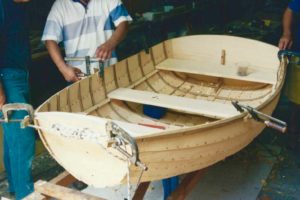 Pee Wee is an ideal yacht tender at 2.1m (6’8″)and can be built with traditional clinker planking, plywood clinker planking or strip planking. The original Pee Wee was designed by Ian Smith to be the tender to his canoe yawl Tirrick in the 1980’s and was strip-planked and sheathed with glass cloth set in WEST System Epoxy resin. It was such a stable little dinghy that Ian drew up a traditional clinker construction plan and it became the subject of the majority of the Sydney Wooden Boat School’s Traditional Clinker classes in the 1990’s, some planked in Huon Pine and some in Australian Red Cedar, and one in White Beech. The Traditional Clinker manual, also available, focuses on the building of her bigger sister Petrel, a very similar boat.
Pee Wee is an ideal yacht tender at 2.1m (6’8″)and can be built with traditional clinker planking, plywood clinker planking or strip planking. The original Pee Wee was designed by Ian Smith to be the tender to his canoe yawl Tirrick in the 1980’s and was strip-planked and sheathed with glass cloth set in WEST System Epoxy resin. It was such a stable little dinghy that Ian drew up a traditional clinker construction plan and it became the subject of the majority of the Sydney Wooden Boat School’s Traditional Clinker classes in the 1990’s, some planked in Huon Pine and some in Australian Red Cedar, and one in White Beech. The Traditional Clinker manual, also available, focuses on the building of her bigger sister Petrel, a very similar boat.
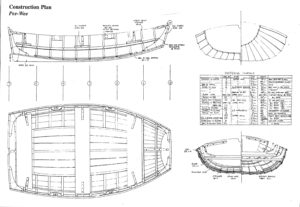 The Traditional Clinker construction plan contains the fastening list as well. The plans contain full size patterns for the moulds and for the bow and stern transoms, so no lofting is necessary. Details for ply clinker and strip-planked construction are also included.
The Traditional Clinker construction plan contains the fastening list as well. The plans contain full size patterns for the moulds and for the bow and stern transoms, so no lofting is necessary. Details for ply clinker and strip-planked construction are also included.
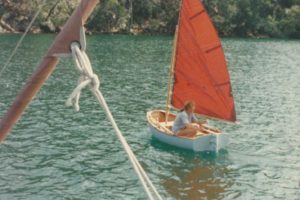 The original Pee Wee was strip-planked and had an unstayed gunter rig, but the centreboard case just forward of the main thwart meant that the rower would often get a wet bum.
The original Pee Wee was strip-planked and had an unstayed gunter rig, but the centreboard case just forward of the main thwart meant that the rower would often get a wet bum.
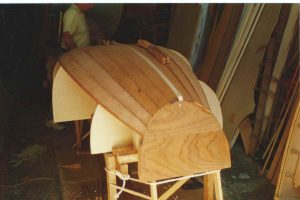
Pee Wee is built upside down, as in this shot of a half-planked boat in Australian Red Cedar.
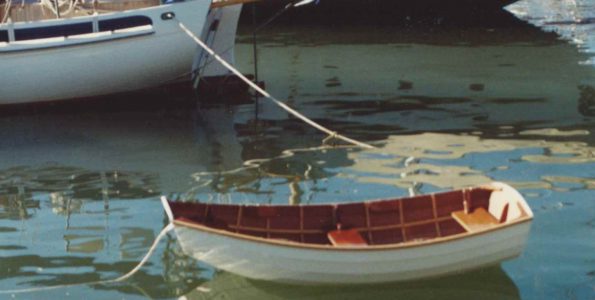
Petrel is a slightly larger version of the Pee Wee dinghy, designed by Nigel Shannon. It makes an ideal yacht tender with good performance characteristics like easy rowing and stability. Detailed building instructions are in the Wooden Boatbuilding – The Sydney Wooden Boat School Manuals. It can be built with traditional clinker planking, ply clinker planking, or strip-planked.
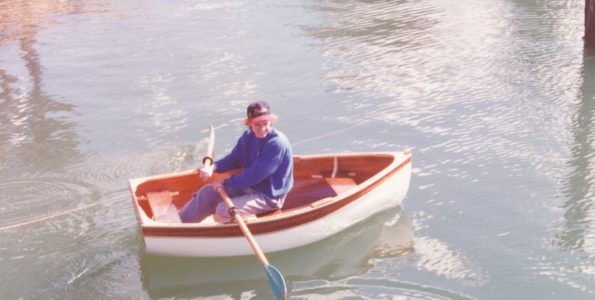
We were looking for a design for a stem dinghy that was only 2.2m long but could still be relatively stable as well as attractive. Jordan Smith drew up the lines and we built the first boat in a regional class in Newcastle in 1994. The boat proved to be exactly what we wanted, attractive and stable for its size. After that we built Pippies by four different methods, strip-planked, ply clinker, traditional clinker and diagonally-planked. Each method can produce a fine vessel.
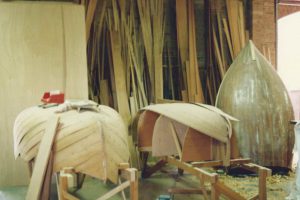
One customer built a traditional clinker version as a tender to his yacht and decided it was too nice to go in the water, so he turned it into a coffee table and built a plywood clinker version for a tender. I have an incomplete traditional clinker Cedar Pippy that will become the tender for my Ranger 24 when completed.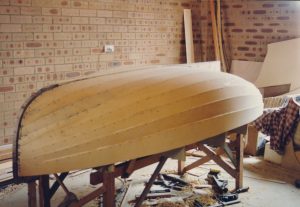
Generally speaking Pippy is built upside down in all methods, but the traditional clinker planked boat can be built right way up.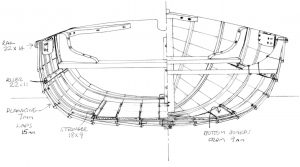
The construction details for strip-planking, traditional clinker construction and plywood clinker construction are all in the plans.
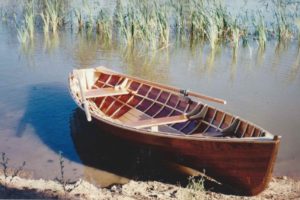 Bill Fisher of Drummoyne then Putney, from the famous Sydney boatbuilding family, built the original of this boat in his retirement for his own use in 1947. He built it like the Watermen’s skiffs that were common before the turn of the 20th Century when he began to learn his trade. Ian Smith took the lines off Eva Seabird in 1992, and quite a few boats have been built to this design since. It can be built traditionally clinker planked, or with glued plywood clinker construction or strip-planked. This boat pictured was built by Brendan McMurdo.
Bill Fisher of Drummoyne then Putney, from the famous Sydney boatbuilding family, built the original of this boat in his retirement for his own use in 1947. He built it like the Watermen’s skiffs that were common before the turn of the 20th Century when he began to learn his trade. Ian Smith took the lines off Eva Seabird in 1992, and quite a few boats have been built to this design since. It can be built traditionally clinker planked, or with glued plywood clinker construction or strip-planked. This boat pictured was built by Brendan McMurdo.
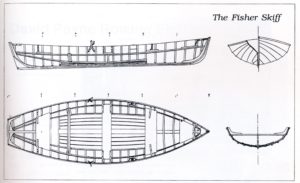
There is a separate construction plan for traditional clinker construction, and another sheet shows details for ply clinker and strip planking. Beam is 1.35m (4’5″). Eight-foot oars are about right.
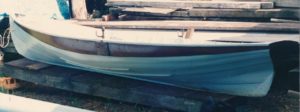 This is the original boat, known as the Eva Seabird. The family story goes that Bill Fisher wanted to call it Seabird but his sister Eva wanted it named after her, so it became Eva Seabird. In the 1950’s Bill , at the time in his 80’s, raced another veteran Tom Hall from Palm Beach to Manly (about 18 nautical miles, offshore) and won in a strong offshore Westerly. The builder’s great-grandson was working for me in 1992 at River Quays Marina opposite the Fisher shed in Putney, and Stuart rowed the boat to work. I asked his grandfather, the oldest family member still alive at that point if I could take off the lines, which he was happy to agree to.
This is the original boat, known as the Eva Seabird. The family story goes that Bill Fisher wanted to call it Seabird but his sister Eva wanted it named after her, so it became Eva Seabird. In the 1950’s Bill , at the time in his 80’s, raced another veteran Tom Hall from Palm Beach to Manly (about 18 nautical miles, offshore) and won in a strong offshore Westerly. The builder’s great-grandson was working for me in 1992 at River Quays Marina opposite the Fisher shed in Putney, and Stuart rowed the boat to work. I asked his grandfather, the oldest family member still alive at that point if I could take off the lines, which he was happy to agree to.
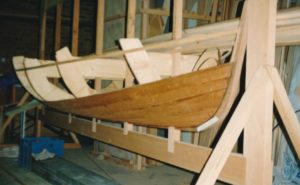 The first one we built was built at various shows in 1993. When our shed moved to Glebe Point we kept the boat in davits and often rowed it all around Sydney Harbour. This style of clinker boat is built upright when planked traditionally. The ply clinker and strip-planked versions are easier built upside-down.
The first one we built was built at various shows in 1993. When our shed moved to Glebe Point we kept the boat in davits and often rowed it all around Sydney Harbour. This style of clinker boat is built upright when planked traditionally. The ply clinker and strip-planked versions are easier built upside-down.
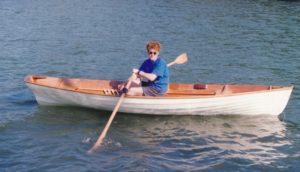 A ply clinker version was next, built in a Summer School class, and proved to be an excellent rowing boat like the traditional one, being lighter it was marginally faster, except against a headwind. The plans come with full-size patterns for the moulds as well as the stem and stern knees and transom.
A ply clinker version was next, built in a Summer School class, and proved to be an excellent rowing boat like the traditional one, being lighter it was marginally faster, except against a headwind. The plans come with full-size patterns for the moulds as well as the stem and stern knees and transom.
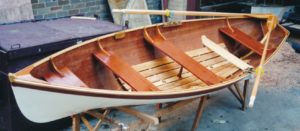 The first strip-planked version was next, also built in a class. This one also had a pair of custom 9’oars on fold-out rowlocks as requested by the customer who eventually bought it.
The first strip-planked version was next, also built in a class. This one also had a pair of custom 9’oars on fold-out rowlocks as requested by the customer who eventually bought it.
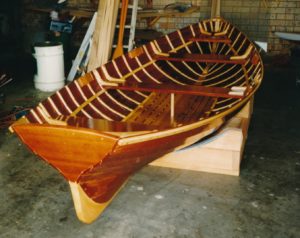 Several others have been built, including this beautiful traditional version by Allan Cumner in Bundaberg Queensland.
Several others have been built, including this beautiful traditional version by Allan Cumner in Bundaberg Queensland.
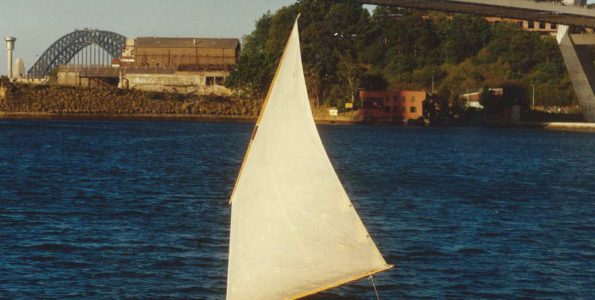
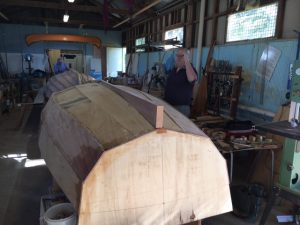 At the School in the early 1990’s we needed a boat that would be a good introduction to a number of boatbuilding techniques but be simple enough for a class to structurally complete in two busy weekends. I drew up the Whiting Skiff to be pretty much a maximum size for car-topping. The lucky result was that it is not only a good boat for learning techniques, it is a terrific boat in the water.
At the School in the early 1990’s we needed a boat that would be a good introduction to a number of boatbuilding techniques but be simple enough for a class to structurally complete in two busy weekends. I drew up the Whiting Skiff to be pretty much a maximum size for car-topping. The lucky result was that it is not only a good boat for learning techniques, it is a terrific boat in the water. 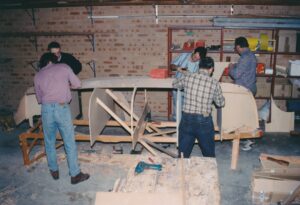 It can be rowed or sailed or even motored with a small outboard.
It can be rowed or sailed or even motored with a small outboard.
The plans contain two optional rigs, a simple unstayed standing lug rig and a gunter rigged sloop with small jib.
Full step-by-step instructions are found in my book Wooden Boatbuilding – The Sydney Wooden Boat School Manuals.
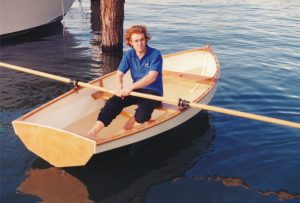
We still have one that we sail occasionally. It has proved to be an ideal boat for a Mens Shed project.